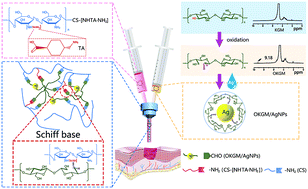A self-adapting hydrogel based on chitosan/oxidized konjac glucomannan/AgNPs for repairing irregular wounds†
Abstract
Wound dressings play a critical role in the cutaneous healing process. The uncertainty of an injury leads to an irregular wound. However, incomplete contact between a general dressing and wound reduces the effectiveness of the dressing. Therefore, self-adapting hydrogels that are adhesive, injectable, and self-healable are being developed to efficiently treat irregular skin wounds. Here, we present an approach based on dynamic Schiff-base bond formation to prepare self-adapting hydrogel dressings that automatically adapt to irregular wounds under natural conditions and sustain total contact with the injured site. Spectroscopic investigations suggested the formation of dynamic covalent Schiff-base bonds, which are closely associated with the rapid formation of the hydrogel, between the aldehyde groups of oxidized konjac glucomannan and amine groups in the backbone of protonated chitosan and protonated tranexamic acid. Rheological analysis confirmed the self-healing property of the hydrogel, that is, the recovery of the broken hydrogel network. Histological analysis indicated that this self-adapting hydrogel provides a clear advantage over the commercial hydrogel dressing (AquacelAg™) in the in vivo wound-healing process. Our rapidly gelating hydrogel formulations with self-healing ability, tissue adhesiveness, and antibacterial activity are very promising self-adapting biomaterials for repairing irregular wounds.



 Please wait while we load your content...
Please wait while we load your content...